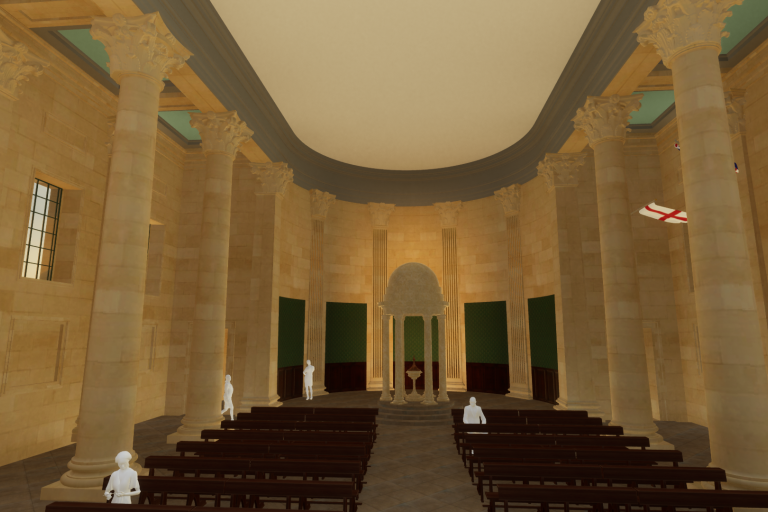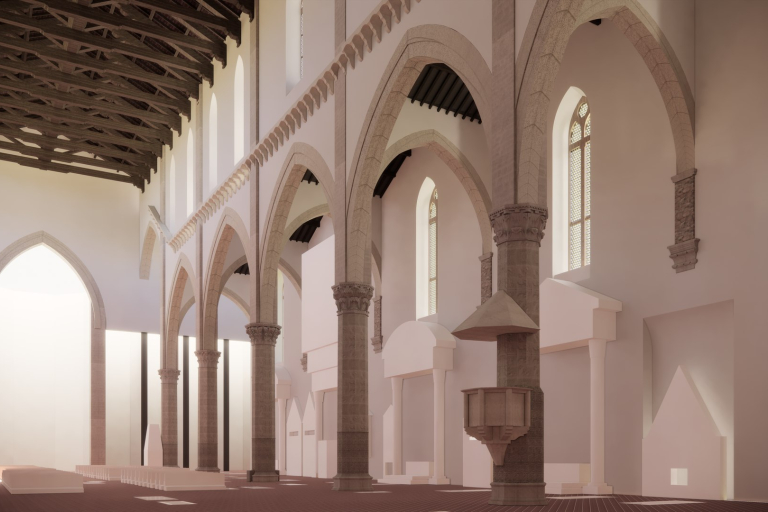In the realm of architectural preservation and renovation, churches stand as iconic symbols of heritage and culture, encapsulating centuries of history. However, churches, with their intricate designs and cultural significance, pose unique challenges for conservationists and renovators alike. Enter Building Information Modeling (BIM) Church 3D Modeling Services, a groundbreaking solution poised to revolutionize the way we approach the restoration and revitalization of these sacred structures. Therefore, in this blog post, we delve into the profound impact of BIM in revitalizing churches. And we explore its role in preserving historical integrity, facilitating collaborative design processes, and unlocking innovative solutions for adaptive reuse.
Challenges in Church Conservation and Renovation
Preserving historical churches presents a unique set of challenges that demand careful consideration and strategic planning. In addition, navigating the complexities of church conservation and renovation requires a nuanced approach. This encompasses aspects such as structural integrity, historical accuracy, and regulatory compliance. These factors demand careful consideration to ensure successful preservation and renovation efforts. Therefore, here are some common challenges we encounter in these endeavors. And we will examine why traditional methods may struggle to adequately address them.
Structural Integrity
Historical churches often exhibit intricate architectural features and construction techniques that have stood the test of time. However, aging materials, exposure to environmental elements, and structural degradation pose significant threats to their integrity. Moreover, Traditional renovation methods, such as piecemeal repairs or superficial refurbishments, may fail to address underlying structural issues comprehensively. Without a thorough understanding of the building's structural dynamics, there is a risk of exacerbating existing problems. Additionally, compromising the stability of the entire structure becomes a concern.
Historical Accuracy
Preserving the historical authenticity and architectural significance of churches is paramount in conservation efforts. Yet, achieving historical accuracy while incorporating modern amenities or addressing functional requirements can be challenging. Moreover, Traditional renovation approaches may prioritize functionality over authenticity. This can lead to the loss of original features or the introduction of incompatible design elements. Striking a balance between preserving historical integrity and meeting contemporary needs requires a meticulous approach. Traditional methods may struggle to achieve this delicate balance.
Regulatory Compliance
Historical churches are subject to various preservation laws, zoning regulations, and building codes. These regulations aim to safeguard their cultural heritage and ensure public safety. Navigating the complex web of regulatory requirements can be daunting, particularly when renovating structures with historical significance. Traditional renovation practices may overlook or inadequately address regulatory considerations, leading to delays, fines, or legal complications. Compliance with modern standards while respecting historical authenticity necessitates a comprehensive understanding of regulatory frameworks. This requires specialized expertise that traditional methods may lack.
Read more: Enhancing Renovation Projects with Point Cloud to BIM Technology
How BIM Church 3D Modeling Services Solve These Challenges.
Traditional methods often struggle to address these challenges effectively, leading to compromises in preservation efforts. However, BIM Church 3D Modeling Services offer innovative solutions that mitigate these challenges. They ensure the successful conservation and renovation of these sacred spaces.
Firstly, BIM Church 3D Modeling Services provide accurate documentation of existing church structures, capturing intricate details and dimensions with precision. This detailed digital representation serves as a foundational resource for conservationists, architects, and engineers, enabling thorough analysis and informed decision-making.

Secondly, BIM facilitates structural analysis and simulations, allowing stakeholders to assess the condition of church buildings and identify potential vulnerabilities. By conducting structural assessments and performance analyses, BIM helps in understanding the structural dynamics and predicting risks. This ensures targeted interventions to reinforce stability while preserving historical integrity.
Moreover, BIM Church 3D Modeling Services enable clash detection, identifying potential conflicts between proposed design changes and the existing structure. This proactive approach helps in avoiding clashes between modern updates and historical features. Besides, it ensures compatibility and preserves the authenticity of the church.
Additionally, BIM enhances collaboration among stakeholders, fostering a synergistic approach to conservation and renovation projects. By facilitating communication and coordination among architects, engineers, historians, and conservationists, BIM ensures that all aspects of the project are considered. This includes considerations such as structural integrity, historical accuracy, and regulatory compliance.
Furthermore, BIM Church 3D Modeling Services streamline the renovation process, minimizing costly rework and delays. Through 3D visualization and virtual walkthroughs, stakeholders can explore different design scenarios and assess their impact. This allows them to make informed decisions about conservation strategies, ensuring that the outcome aligns with preservation objectives.
BIM Church 3D Modeling Services from Harmony AT
BIM Church 3D Modeling Services from Harmony AT stand at the forefront of innovative solutions for the conservation and renovation of historical churches. Harmony AT offers a comprehensive suite of services tailored to the specific needs of each project, leveraging a deep understanding of the unique challenges posed by these endeavors. Their expertise ensures that they can address the complexities inherent in church conservation and renovation projects effectively.

Our team of skilled professionals utilizes cutting-edge BIM technology. They create precise digital representations of church structures. These representations capture every intricate detail with accuracy and authenticity. Harmony AT's BIM services encompass detailed documentation, structural analysis, and clash detection. These services empower stakeholders to navigate the complexities of church conservation with confidence and precision.
Moreover, our collaborative approach fosters communication and coordination among project stakeholders. This ensures that stakeholders align conservation efforts with preservation objectives while meeting contemporary needs. With a commitment to excellence and a passion for preserving architectural heritage, Harmony AT's BIM Church 3D Modeling Services set the standard for excellence in the field. Their dedication ensures that historical churches continue to inspire and awe for generations to come.
Read more: Shaping Tomorrow's Hospitality: The Power of BIM Hotel 3D Model
Essential Tips for Church Renovation & Restoration
For architects, contractors, and project managers embarking on church conservation and renovation projects, several practical tips and recommendations can ensure the success of these endeavors:
Historical Research
Conduct thorough historical research to understand the significance of the church and its architectural features. This will inform decision-making throughout the conservation process and help preserve the building's authenticity.
Collaborative Approach
Foster open communication and collaboration among all stakeholders, including historians, conservationists, engineers, and religious authorities. By integrating diverse expertise, you can ensure that conservation efforts align with preservation objectives while meeting contemporary needs.
Detailed Documentation
Utilize Building Information Modeling (BIM) technology to create detailed digital documentation of the church structure. This will provide a comprehensive understanding of the building's condition and facilitate informed decision-making during the renovation process.
Structural Assessment
Conduct thorough structural assessments to identify any weaknesses or vulnerabilities in the church structure. This will help prioritize conservation efforts and ensure the safety and stability of the building.
Regulatory Compliance
Familiarize yourself with preservation laws, zoning regulations, and building codes relevant to church conservation projects. Besides, ensure that all proposed renovations comply with these regulations while respecting the historical integrity of the building.
Preservation of Original Materials
Whenever possible, preserve and restore original materials and architectural elements. This will help maintain the authenticity of the church and contribute to its historical significance.
Sensitivity to Religious Practices
Consider the religious significance of the church and its impact on worship practices. Ensure that proposed renovations respect and accommodate religious rituals and traditions.
Community Engagement
Engage with the local community and stakeholders to garner support for the conservation project. Seek input and feedback from parishioners, historical societies, and preservation organizations to ensure that the project reflects community values and priorities.
Budget and Timeline Management
Develop a realistic budget and timeline for the conservation project, considering the complexities and challenges involved. Regularly monitor progress and adjust plans as needed to ensure that the project stays on track.
Long-Term Maintenance Plan
Developing a long-term maintenance plan is essential to ensure the continued preservation of the church after the renovation is complete. This plan will help address ongoing maintenance needs and prolong the lifespan of the building. Regular inspections and maintenance activities will help prevent deterioration and prolong the lifespan of the building.
Experience the transformative power of BIM Church 3D Modeling Services from Harmony AT today. And elevate your church conservation and renovation projects with our cutting-edge technology and expert guidance. Contact us now to embark on a journey of precision, authenticity, and excellence in preserving architectural heritage.
In conclusion, BIM church 3D modeling services play an indispensable role in the conservation and renovation of historic religious structures. By utilizing advanced Building Information Modeling (BIM) technology, these services offer detailed and accurate representations of existing conditions, enabling precise planning and execution of restoration efforts. This approach ensures the preservation of architectural heritage while integrating modern standards for safety and functionality. Embracing BIM for church renovations not only safeguards the past but also enhances the future sustainability and usability of these cherished landmarks, making it an invaluable tool for any conservation project.
Categories





